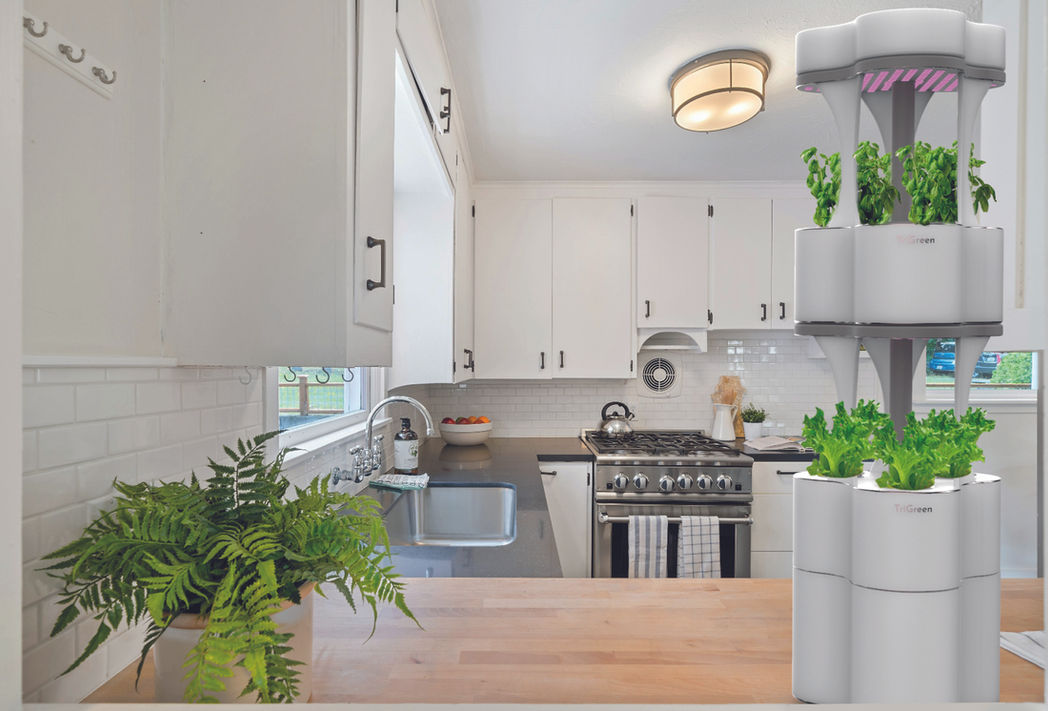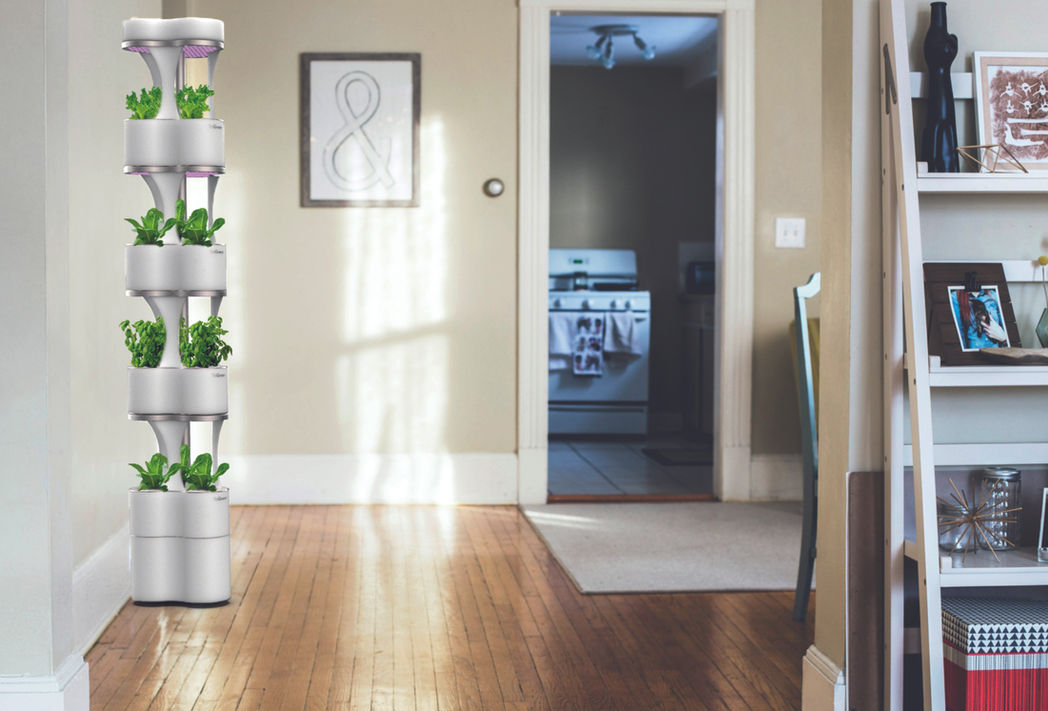
TriGreen
An indoor, compact hydroponics system
TriGreen is a compact, indoor smart hydroponics system that allows users to enjoy the growth and consumption of fresh produce from the comforts of their home. It is offered in modular sets allowing multiple units to be stacked at a time.
The vertical nature of this system solves the issue of increasingly limited space that many urbanities living in Singapore face today. The overall structure also acts as a decorative feature in homes. The app generates alert notifications, tracks the progress of the conditions of the plants and holds an online community for users to share their experiences.
Nanyang Technological University Singapore
DR3006 Product Design III
OVERVIEW
DURATION
September - November 2020 (2 months)
ROLES
UI/UX Designer, Product Designer, CAD Designer
SOFTWARES



Hydroponics is a method of growing plants without soil by using mineral nutrient solutions in a water solvent. Many benefits of hydroponics includes water conservation, fewer chemicals, healthier needs and most importantly bigger yields. This coincides with Singapore’s “30-by-30” goal to produce 30% of Singapore’s nutritional needs locally by 2030. With 90% of Singapore’s food imported from neighbouring countries, the idea of growing own produce from the comforts of one’s home seems an ideal scenario. Singapore is vulnerable to the volatility of the global food market.
01 /
OVERVIEW

Creating a compact, indoor hydroponics system with a simple and intuitive user experience.
A compact, indoor hydroponics system that allows users to enjoy the growth and consumption of fresh produce from the comforts of their home, through an pp with step-by-step instructions and a readily available kit of the unit and seeds.
The complexity and constant maintenance of growing hydroponics is the main concern, especially with the hustle and bustle fo Singapore. Poor management of the produce such as inadequate water, lighting, nutrients, can result in improper growing conditions.
02 /
CHALLENGE
By incorporating current technology and agriculture methods, this creates a simple and hassle-free hydroponics system that promotes cultivation of vegetables and fruits for household needs, and can accommodate to the user’s lifestyle.
The primary goal is to use technology to help bring back natural elements back into homes of Singapore’s concrete jungle, by allowing users to grow their own vegetables for personal consumption in a clean and efficient way.
03 /
GOAL
Design Process
1
2
3
4
5
Empathise
Research
Define
User Persona
Ideate
User flow, Sketches
Build
Wireframes, Prototype
Test
Final UI Screens

Primary Research
RESEARCH METHOD
An online survey with 34 participants was conducted to better understand my users. The questions are in regards to users’ attitudes and opinions towards hydroponics.
The survey consists of a range of multiple choice and open ended questions.
• Are you interested in eating produce that is hydroponically grown?
• What kind of housing estate do you live in?
• What is the most important factor when buying produce?
Questionnaire Results

75%
Interested in having personal hydroponics system

88%
Live in Apartment/HDB, compared to a landed property

68%
Would opt for locally produced vegetables

81%
Are full-time students or working adults who have "busy schedules"
RESEARCH METHOD
Secondary Research
Narrowing scope
Only green, leafy vegetables with similar growing conditions will be successful. This allows for multiple different vegetable to be grown in a close environment with a mutual source of nutrients and water.
How does the system work?
Factors Ideal conditions
Light 16 hours a day
Temperature Daytime 26 - 28 C
Nighttime 20 - 23 C
Clone above 80%
Grow stage 60%-80%
Bloom stage 50%-60%
Humidity
pH level 5.8 to 6.8
6.3 is considered optimal
IDEATION
Visual Storyboard

DEFINE
System Breakdown

Purchase 1 unit of the product including first two months worth of pods = 20 pods
Users will open the box to reveal instructions on how to set up properly
a) Place seeds inside rockwool cubes
b) Soak rockwool cubes and germinate seeds until it grows 2-3 inches tall with 3-4 leaves
c) Then, place rockwool cubes into nesting cup
d) Measure and pour required amount of water into water reservoir
e) Measure and pour ratio of each nutrient solution into water reservoir and stir well
Connect to mobile app using WiFi (indoors)
Users monitor the growth of their plants in real-time using the app
Users will be alerted when plants have failed to grow properly and the system will assess faults and inform users
Users will be alerted when plants are ready to be picked to be used in cooking ingredients
If users choose to grow more plants they may choose to purchase another unit to add to the modular collection
Users can use the app to view range of pods and order individual pods OR subscribe to a monthly subscription service

USER PROFILE
Target Audience
The three types of target audience for my project will most likely be aimed at people who would use this unit for their profession (teachers and botanists), the other would be house owners who would use it when on vacation, and the last would be strong garden enthusiasts who enjoy it as a hobby.
All of these are aimed at males AND females with interests in gardening or cooking or for commercial uses. From research, I have concluded that the majority of the customers would be specifically be between the 25-34 age group, however I have decided not to limit it to this as my customers may be all ages 25+.
USER RESEARCH
User Persona
Using the quantitative and qualitative data from the survey results, I created three target profiles to better empathise with the user's needs.
Note: these are based purely from assumptions and the survey results.



South East Asia, specifically Singapore; mainly warm seasons, urban or suburban areas– city or suburbs.
Aged 25-55; both genders– male AND female, part-time OR full-time workers OR housewives; marital status– single and/or married; with or without children; middle to high disposable income.
Likes– travelling but not too frequently, relaxing at home, interests in gardening and nature, few interests in fitness and health
Behaviour– tends to stay inside, lack of exercise
Value– does not mind spending a majority of their income on spending it on the care of their plants.
Geographic
Demographic
Psychographic

User Goals
After identifying the user personas, and the different types of users that may use the product, I defined the user goals to helps us influence our design decisions to consistently address our key goals.
1
View plant conditions in real-time
2
View water level in real-time
3
Receive alert notifications for poor plant conditions
4
Receive alert notifications for low water level
IDEATION
Product Features Mapping


IDEATION
User Flow
Designing our user flow allowed me to better understand the user journey to complete specific tasks, and allows me to view the flow of screens to craft later.

IDEATION
Initial Sketches
We started sketching screens of top priority to help us brainstorm and refine ways of presenting the information that users could easily understand. We ideated different ways for the functions we had prioritised, and discussed to continuously improve and generate new and innovative features.

PROTOTYPING
Low-fidelity mockups
After understanding our wireframe sketches and thinking about the preliminary flow, we proceeded to translate the sketches into digital low-fidelity mockups, crafting the screens using simple shapes for the composition. This allowed us to test the functionality of the product as well as attempt to visualise the whole user experience.

PROTOTYPING
Adobe XD
Screens

DISPLAY
Final Interfaces



Usability Testing
I asked a group of 5 people aged 21-35 to test the prototype, to identify user pain points and difficulties. I asked them to complete a set of tasks that can help me observe the way they navigate through the app.
The questions include but are not limited to:
1. Can you scan the unit successfully?
2. Can you add your choice of produce successfully?
3. Can you view the overall visual charts, statistics and history information?
4. Can you upload a photo to the shared community?
5. What is the overall experience like?
6. What improvements can be made?
TESTING
















